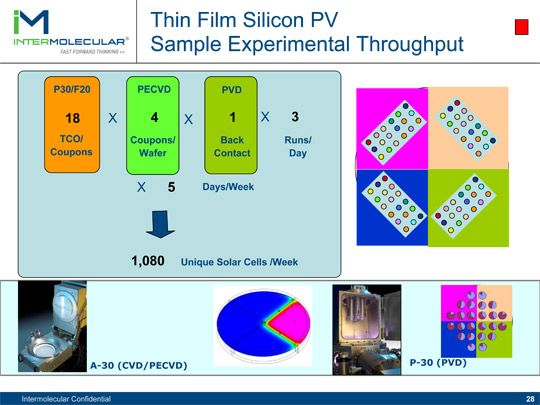Intermolecular might not have made every top ten list of likely IPO candidates, but the sort-of-greentech company just filed their S-1 form with the SEC.
Although Intermolecular isn't a pure-play greentech company (most of its business is currently in the semiconductor industry), the firm certainly is looking to work in the photovoltaic and LED lighting sectors.
Through paid collaborative development programs with customers, Intermolecular develops proprietary technology and intellectual property focused on advanced materials, processes, integration and device architectures. Founded in 2004, Intermolecular is based in San Jose, California.
The firm acts as an R&D accelerator and in turn, Intermolecular gets a royalty from products sold that were developed with its technology.
According to the S-1, the firm had 2010 revenues of $42.6 million with losses of $1.7 million. Compared to the majority of greentech S-1s that have been filed lately (see Enphase or Aspen Aerogels or BrightSource Energy), that's a relatively healthy situation. Revenue in the first quarter was $11.7 million with losses of $1.2 million. Most of the revenue comes from the CDP programs.
The firm had 167 full-time employees as of the filing of the SEC document.
Intermolecular is VC-funded, with ATMI owning 10.6 percent, CMEA owning 20.7 percent, Redpoint owning 20.9 percent, Symyx owning 10.9 percent, and USVP owning 14.8 percent. Intermolecular has a post-IPO obligation with Symyx: "If and to the extent the gross proceeds from the sale by Symyx of shares in this offering are less than $67 million, we will use a portion of our net proceeds to satisfy an obligation to Symyx in connection with an agreement for the purchase of IP from Symyx and the termination of related royalty obligations. We have also agreed to reimburse Symyx for 50% of their underwriting discounts and commissions."
According to the SEC document, "We currently target large, high-volume semiconductor and high-growth emerging clean-energy markets, including DRAM, flash memory, complex logic, flat glass, solar cells, LEDs and other energy-efficient technologies with our HPC platform. Within these broad markets, we have engaged in paid programs for 17 customers, including ATMI, Elpida Memory, GLOBALFOUNDRIES, Guardian Industries, SanDisk, Taiwan Semiconductor Manufacturing Company (TSMC) and Toshiba. ATMI and Elpida have commenced shipping products incorporating technology developed through our CDPs and pay us licensing and royalty fees."
Note the lack, so far, of solar and LED firms in that list. It's less than convincing to call the firm a greentech company. And what works in the semiconductor model doesn't always work in photovoltaics.
Intermolecular claims it has mastered the ability to do many experiments on a single wafer -- up to 72 experiments per cycle. These are essentially miniaturized and site-isolated experiments. As an example: a wafer can be run with 18 different silicon wafer texturing processes, each with four different passivation techniques.
In a project that would take another company months and tax their analytical capabilities, Intermolecular can have a throughput of hundreds of uniquely characterized solar cells per week. Intermolecular has the flexibility to change gases, targets, chemistries and integration schemes. This is combined with automated probing and an "Informatics" software system that in many ways is similar to the techniques employed in biotech.
The firm has started working on projects aimed at improving alkaline texturing of monocrystalline silicon wafers and developing a more durable, lower cost antireflective coating for PV glass. The latest initiative getting underway is a development program focused on making high-efficiency CIGS more readily manufacturable. The company is also considering programs targeting optimized transparent conductors and efficiency enhancements for earth-abundant PV materials like CZTS. Longer-term ambitions include LEDs, thin-film batteries, super-capacitors, and electrochromics.
There is a difference in the nature of semiconductor design and photovoltaic design and it's a difference that could limit Intermolecular's push into solar power. The IP in a semiconductor design is about clever layout and intelligent circuit and module design, as well as process, whereas the IP in a PV cell is often the process itself. Solar firms might be reluctant to share the entirety of their secret sauce with the good people at Intermolecular.
CMEA has a related portfolio firm, Wildcat Discovery Technologies, which rather than looking for new processes, instead searches for new materials for use in photovoltaics, batteries and in carbon capture.
As stated in the S-1, "We are still proving our business model, and we have not yet demonstrated our ability to generate significant revenue, particularly licensing and royalty revenue. As a result, it may be difficult for public market analysts and investors to evaluate our future prospects."
Intermolecular does have very intriguing science, but the firm is not a product company and borders on being a materials company with a big licensing component. The markets are not always appreciative of that model.




